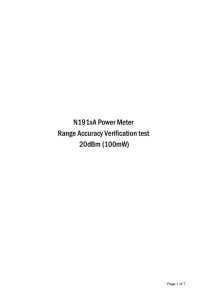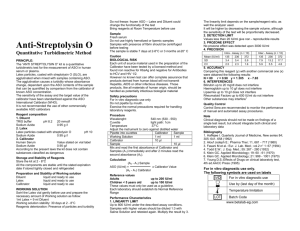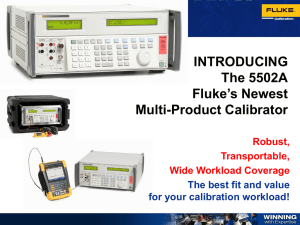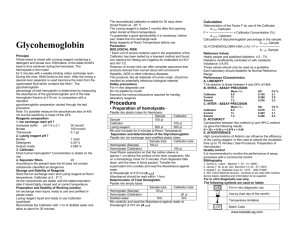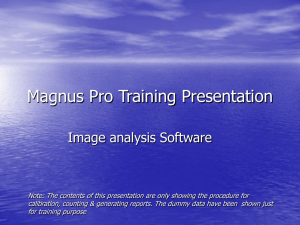Calibration & Flagging
advertisement
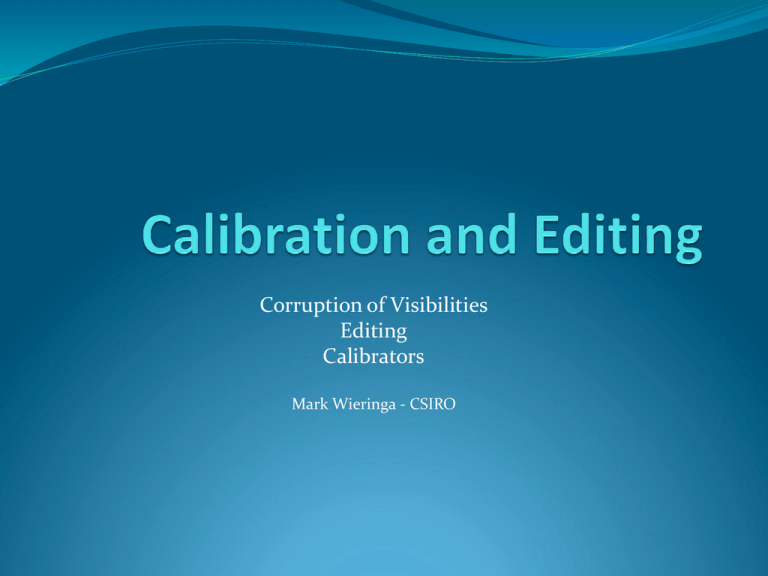
Corruption of Visibilities Editing Calibrators Mark Wieringa - CSIRO Why Calibrate? High-quality images Meaningful, accurate measurements Understand your instrument! The messy truth… FT(Observed Visibilities) ≠ Pretty Image Atmosphere Ionosphere Troposphere Antenna/Feed On-axis gain/sensitivity vs El Primary beam correction Pointing Position (location) LNA+conversion chain Clock Gain, phase, delay Frequency response Digitiser/Correlator Auto-levelling Sampling efficiency Birdies Measurables: Amplitude Phase Delay Rate Polarization Spectrum The Measurement Equation j i Vpp V Vij= pq Vqp Vqq J i = Jp Jq Vij The Measurement Equation Antenna based: Jvis = B G D P B = bandpass G = complex gain D = pol leakage P = receptor pos angle (2x2 matrices) Baseline based gain errors Correlation corrections Sky Intensity Distribution Polarization Conversion Antenna beam + pointing Faraday Rotation Baseline based additive Aij = noise + RFI + offsets Simplified Model Vijobs = (Ji Jj) Vijmod + noise (vectors of 4 polarizations) Just look at antenna based gain, leakage and bandpass Ignore or separate out other terms Antenna based terms: Ji = Bi (v) Gi(t) Di (vectors of 2 pol.) Solve iteratively, one/two component(s) at a time Minimize χ2 = ij,t |Vijobs(t) - (Ji(t) x Jj(t)) Vijmod2 Use calibration sources (calibrators) to simplify the process Strong point source Can ignore noise and source structure Known, stable flux-density No time dependence, fixes flux scale Little or no polarization Can determine instrumental polarization terms easily Similar scheme works for more complex sources Need to build up a model of the field iteratively See High DR Imaging lecture Visibility corruption RFI – interference Transmitters, Lightning, Solar, Internal RFI Antenna/Receiver/Correlator failures no signal, excess noise, artificial spectral features Bad weather effects get worse for higher freq. decorrelation, noise increase, signal decrease (opacity) Shadowing one antenna (partially) blocked by another Flagging/Editing Rule 1. Don’t be afraid to throw out data Corrupted data can reduce the image quality significantly Effect of missing data (even 25%) is often minor and easily corrected in deconvolution Rule 2. Flag data you know is bad early Save your sleuthing skills for the hard stuff See “Error recognition” talk Rule 3. Use shortcuts where possible Detailed visual inspection of all data is rapidly becoming impossible Collapse, average, difference & automate using scripts Flagging/Editing 1st pass: use on-line flags (automatic) Flags when antennas are off source or correlator blocks offline. 2nd pass: Use the observing logbook! Saves lots of time later. Note which data is supposed to be good & discard data with setup calibration, failed antennas, observer typos etc. 3rd pass: Use automatic flags Correlator birdies, Common RFI sources (options=birdie, rfiflag) Shadowed data: select=shadow(25) Data with bad phase stability: select=seeing(300) 4th pass: Check calibrators - plot amp-time, phase-time, investigate outliers & flag, flag source as well if you can't trust data 5th pass: (After calibration) Inspect & flag source data Use Stokes V to flag data with strong sources amp-frq RFI – 1-3 GHz Example: RFI - 16cm spectrum PGFLAG •Interactively flag, tune params •Automatic flagging from script SumThreshold flagging • Subtracts smooth background • Clips on running mean in x and y ATCA calibration sequence Observatory – done after reconfiguration Bulk delay (cable lengths) Baseline (antenna location) – good to 1-5 mm Antenna Pointing – good to 10”-20” User Schedule preparation (observing strategy) dcal/pcal/acal: “Real-time” first-pass approximation Post-observation calibration Calibration – at reconfiguration antenna pointing (global pointing model derived from sources in all Az/El directions) generally correct to better than 10", occassional 20" error single antenna may need reference pointing with nearby cal above 10 GHz baseline lengths (relative antenna positions) generally correct to better than 1-2 mm (depending on weather) error significant at 3mm - correct phase with nearby calibrator global antenna delay (bulk transmission delay in cables) Calibration – Schedule Planning Observe primary calibrator 1934-638(cm), Uranus(mm) 5-15 min, to calibrate the absolute fluxscale cm/1934: can also solve for polarization leakage and bandpass mm: Observe separate bandpass calibrator Use secondary for polarization leakage Observe secondary calibrator (close to target) 1-2 min every 15-60 min Atmospheric, instrumental phase variation, System gain variations; optional: solve leakage, bandpass Observe pointing calibrator (above 10 GHz) a POINTing scan every 30-60 minutes ATCA / VLA Calibrator list Ideal secondary calibrator is strong, small (θ<λ/Bmax) and close to the target (<15°) ATCA + VLA lists ~1000 sources Calibrator database lets you make the optimal choice Primary flux calibrators are also stable with time: PKS1934- 638, PKS0823-500 Above 20GHz , the planets are essentially the only primary flux calibrators all bright compact sources seem to vary at high freq Planets not ideal – resolved on longer baselines / seasonal variation Calibration – starting up Calibration done at start of observation: Delay calibration Correct residual path length for your particular frequency & correlator setup Fixes phase slope across band Amplitude & Phase Equalize gains, zero phases, sets Tsys scale helps to detect problems during observation. Polarization zero delay & phase difference between X & Y feeds uses noise source on reference antenna to measure phase. generally correct to a few degrees at 3-20cm Initial array calibration acal pca l ddcal During the observations Observations of secondary calibrator [+ pointing cal] Tsys correction estimates system temp from injected noise corrects for e.g., ground pickup & elevation, but not for atmospheric absorption At 3mm: use Paddle scan calibration instead Calibration data recorded during the observation: Tsys – system temperature XY-phase difference on each antenna (experimental) Water Vapour Radiometer path length Post-observation calibration Primary flux calibrator : “bootstrapping” to secondary calibrator Solve for polarization leakages (cross-terms) Use secondary calibrator to correct (“straighten”) the phases Use primary, secondary or other strong point source as bandpass calibrator Secondary Calibrator gains Bandpass Calibration Wide bandwidth calibration Gain, Phase and Calibrator flux vary across a 2GHz band Two approaches possible in Miriad: Divide and conquer [uvsplit maxwidth=0.256] Split data into 4-16 narrow bands, calibrate independently Solve in frequency bins [gpcal nfbin=8] Solve independently, interpolate solutions Advantages: Interpolation fixes phase slope Quicker / less bookkeeping Imaging – combined (PB issue) or separate (SN issue) CASApy has better imaging options Primary calibrator 6.5GHz 4.5GHz Calibrated plot of all channels – Imaginary vs Real Unpolarized; Variation of calibrator flux with Frequency Secondary calibrator 4.5-6.5GHz Uncalibrate d Calibrated in 8 freq bins BP, pol Calibrated Freq Averaged Calibration Recipe Select primary calibrator Solve for complex gain vs time Solve bandpass gain vs frequency Solve polarization leakage (crosstalk between feeds) Select secondary calibrator(s) Apply bandpass and leakage from primary Solve for complex gain vs time Bootstrap absolute flux scale (from primary) Select sources of interest Apply bandpass and leakage from primary and complex gains from secondary Use calibrated data in subsequent imaging and analysis Absolute flux calibration 1Jy = 10-26 W/m2/Hz how?? Real “Primary” flux calibration The big four Cas A Cyg A Vir A Tau A Transferred to ‘secondary’ cals 3C138, 1934-638, Hydra A Summary of Data Reduction Steps For ATCA/CABB data we still mostly use MIRIAD Load the data from the archive format (RPFITS) Apply ‘logbook flags’ and check for bad data on calibrators Calibrate primary cal (G,B,D), transfer to secondary (B,D) Calibrate secondary cal (G), transfer to source (G,B,D) Flag bad data on source (PGFLAG, BLFLAG) Analyze data (imaging, statistics, source fitting) Acknowledgements This talk is based on: John Reynolds’ version of this talk (2003,2006) My version (2001, 2008) The book (ASP Conf Ser Vol 180)
